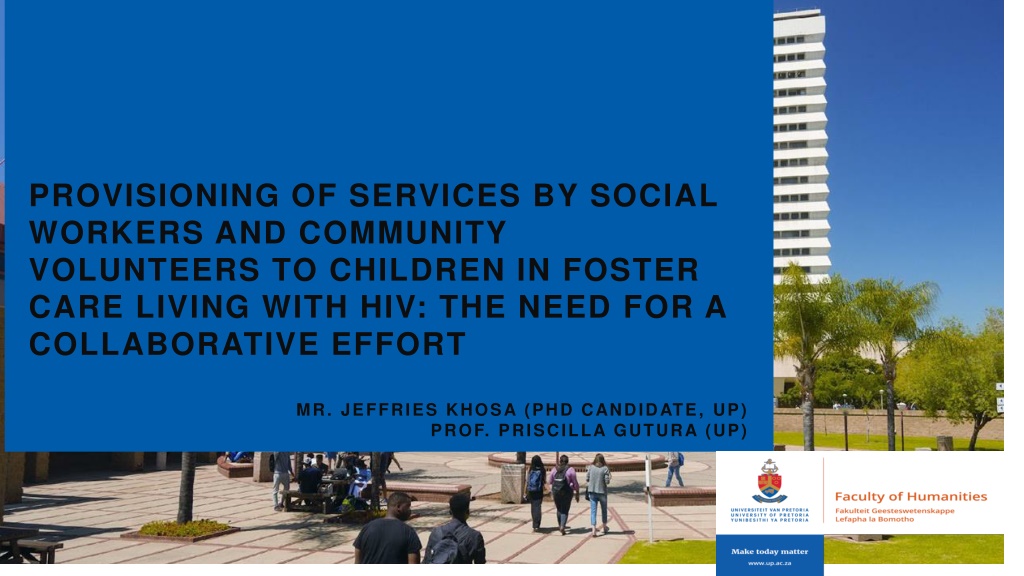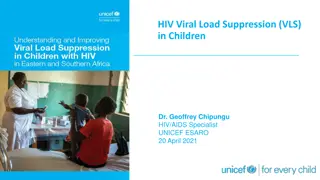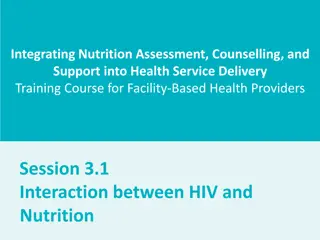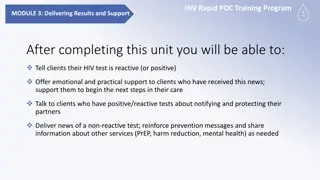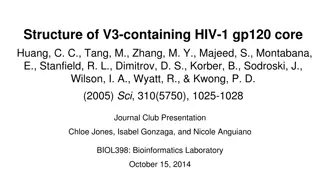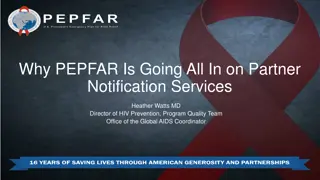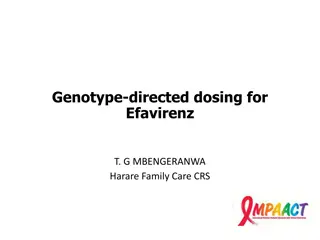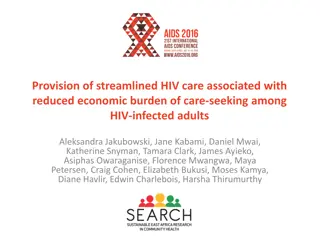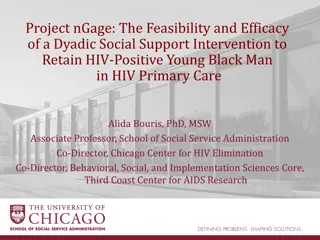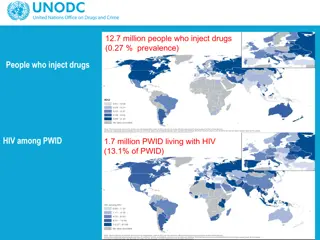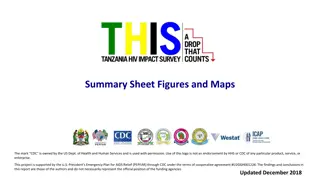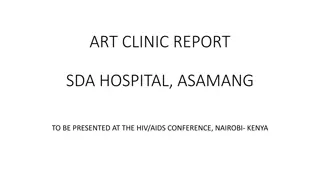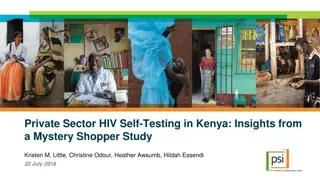Collaborative Efforts in Provisioning Services for Children in Foster Care Living with HIV
Exploring the need for collaboration between social workers and community volunteers in providing services to children in foster care living with HIV, this study highlights the challenges faced by these vulnerable children due to gaps in support and monitoring. By examining the theoretical framework and research methods used, the importance of integrating social support theory, systems theory, and knowledge management theory is emphasized to enhance the care and protection of these children.
Download Presentation

Please find below an Image/Link to download the presentation.
The content on the website is provided AS IS for your information and personal use only. It may not be sold, licensed, or shared on other websites without obtaining consent from the author. Download presentation by click this link. If you encounter any issues during the download, it is possible that the publisher has removed the file from their server.
E N D
Presentation Transcript
PROVISIONING OF SERVICES BY SOCIAL WORKERS AND COMMUNITY VOLUNTEERS TO CHILDREN IN FOSTER CARE LIVING WITH HIV: THE NEED FOR A COLLABORATIVE EFFORT MR. JEFFRIES KHOSA (PHD CANDIDATE, UP) PROF. PRISCILLA GUTURA (UP)
Content of the Presentation Introduction Theorical framework Material and Methods Quantitative results: Social workers Quantitative results: Community volunteers Qualitative findings: social workers Qualitative findings: community volunteers Discussion and conclusion References
INTRODUCTION According to the Children s Act No. 38 of 2005 Section 150(a), orphans are declared as children in need of care and protection. As a result, these children are placed in foster care according to Section 156(e) of the same Act. Most foster care placements are finalised with grandmothers who are old, so there is a challenge of intergenerational gap. To children living with HIV, this is accompanied by missed educational opportunities, poor adherence in HIV treatment, lack of accurate HIV information and so on (Mtshali, 2016: 370-371; Phetlhu & Watson, 2014: 356). Social workers are not able to monitor foster care placements timeously due to high caseloads (Frood & Purssell, 2020:6-7; Hope & van Wyk, 2017:429).
INTRODUCTION (CONTINUES) Therefore, most children in foster care remain vulnerable yet they are in foster care placement. In the study conducted by Khosa (2020: 113), it was shown that the community volunteers find it difficult to work with children in foster care since after the finalisation of foster care, they stop coming to the drop-in centres (DICs). The goal of the study was to determine the care for children in foster care living with HIV by social workers and community volunteers in the City of Johannesburg to develop an effective linkage system.
Theoretical Framework 1. Social support theory Emotional support Instrumental support Informational support Appraisal support 3. Systems theory The theory recognises that the individual does not exist in isolation but forms part of a field made up of a number of different parts like a family, community, NGOs, schools, businesses, governments departments, religious system, and so on. 2. Knowledge management theory Knowledge creation Knowledge transfer Knowledge utilisation
MATERIALS AND METHODS The research approach employed was mixed methods which implied the use of both quantitative and qualitative methods (Creswell & Creswell, 2018:17). Explanatory sequential design was applied which denotes that the quantitative data was collected first and followed by qualitative data and consequently merged, compared, and interpreted (Creswell, 2014: 225; Li, Worch, Zhou & Aguiton, 2015: 2). Study setting was constituted by the Department of Social Development (DSD) service points and the DICs in the City of Johannesburg. The social workers and community volunteers responded to the questionnaires (42 and 100 respectively) and semi-structured interview (14 and 20 respectively). Data analysis: In quantitative phase the statistical analysis was done through SPSS software following the steps of data analysis according to Creswell and Creswell (2018:156). Thematic analysis was used to analyse qualitative data.
Quantitative results: Social Workers (continues) Any services provided to children in foster care living with HIV No 23.8 (N=10) Yes 76.2 (N=32) Services Provided by social workers to children in foster care living with HIV Frequency Percentage To educate children about HIV 21 50% Link them with Department of Health 19 45% To lobby support for in their families structures 15 35.7% Motivate HIV disclosure to significant others 9 21.4% Link them with DICs/CBOs 6 14.3% Provide adherence programmes 1 2.4% Design specific programmes for them 1 2.4% Daily visit to promote/monitor adherence 1 2.4% Other (specify) 1 2.4%
Quantitative results: Social Workers (continues) Services and supervision provided to children in foster care living with HIV Frequency Percentages Last home visit to children living with HIV in my case load. <5 days 1 2.4% 6-10 days 1 2.4% 11-20 days 4 9.5% 21-30 days 3 7.1% >30 days 23 54.8% Do not remember 9 21.4% Not Responded 1 2.4% Last office interaction with children living with HIV <5 days 2 4.8% 11-20 days 2 4.8% >30 days 22 53.4% Do not remember 15 35.7% Not responded 1 2.4%
Quantitative results: Social Workers (continues) Services and supervision provided to children in foster care living with HIV Frequency Percentages Last telephonic conversation with children living with HIV. <5 days 2 4.8% 6-10 days 1 2.4% 11-20 days 3 7.1% 21-30 days 2 4.8% >30 days 20 47.6% Do not remember 12 28.6% Not Responded Last telephonic communication with foster parent 2 4.8% <5 days 3 7.1% 6-10 days 1 2.4% 11-20 days 4 9.5% 21-30 days 4 9.5% >30 days 23 54.8% Do not remember 6 14.3%
Quantitative results: Social Workers (continues) Existing partnership with DICs Yes No p-value Overall (N=9) 21.4% (N=33) 78.6% (N=42) Have drop-in centre in my area. 0.693 No 2 (4.8%) 10 (23.8%) 12 (28.6%) Yes 7 (25.9%) 20 (47.6%) 27 (64.3%) Not responded Number of DICs in my area - - - 0.922 3 (7.1%) 1 2 (20.0%) 6 (18.8%) 8 (19.0%) 2 1 (10.0%) 5 (15.6%) 6 (14.3%) 4 0 (0.0%) 2 (6.2%) 2 (4.8%) 5 1 (10.0%) 1 (3.1%) 2 (4.8%) Not sure Ever referred HIV children in foster care living with HIV to DIC 6 (60.0%) 18 (56.3%) 24 (57.1%) 1.000 1 (2.4%) 4 (9.5%) 5 (11.9%) Yes No 8 (88.9%) 28 (87.5%) 36 (85.7%) Not responded - _ 1 (2.4%)
Quantitative results: Social Workers (continues) Services and supervision provided to children in foster care living with Frequency Percentages HIV Existing partnership with DICs No 32 76.2% Yes 9 21.4% Not responded Need for partnership between myself and DICs 1 2.4% No 2 2.4% Yes 38 90.5% Not responded 2 4.8%
Quantitative results from Community volunteers Current position Social auxiliary worker Community caregiver p-value Overall (N=8) (N=92) (N=100) 1.000 Provide services to orphans living with HIV. 0 (0.0%) 7 (7%) 7 (7%) No 8 (8%) 80 (80%) 88 (88%) Yes - 5 (5%) 5 (5%) Not responded 1.000 Provide services to orphans living with HIV after foster care is finalised. 1 (1%) 14 (14%) 15 (15%) No 7 (7%) 68 (68%) 75 (75%) Yes - 10 (10%) 10 (10%) Not responded 1.000 Foster care placement eliminate children s vulnerability. 3 (3%) 31 (31%) 34 (34%) Yes 0 (0.0%) 1 (1%) 1 (1%) Not sure 5 (5%) 51 (51%) 56 (56%) No - 9 (9%) 9 (9%) Not responded
Quantitative results from Community volunteers: services provided by the community volunteers to children living with HIV. Frequency Percentage Services provided by the community volunteers to children living with HIV. Home visits 97 97% Homework assistance 94 94% Food/nutrition services 91 91% HIV support group 86 86% HIV adherence programmes 80 80% Psychosocial support 79 79% HIV programmes specifically attended by children living with HIV 77 77% Linking children living with HIV to care 69 69% Inter-act with foster parents to ensure or maintain the wellbeing of these children 38 38% Collaborating with foster care social workers strengthening the services to these 19 19% children
Themes and sub-themes for qualitative finding form social workers Themes Sub-themes Sub-theme 1: To provide foster care services, with no special treatment to children in foster care living with Theme 1: Social workers roles in providing services to children in foster care living with HIV HIV. Sub-theme 2: Supervision Sub-theme 3: Disclosure support Sub-theme 4: Linkage to care and referrals. Sub-theme 5: Psycho-social support Sub-theme 6: Informational support Sub-theme 2.1: Lack of training in HIV services Theme 2: Challenges faced by social workers in providing services to children in foster living with HIV. Sub-theme 2.2: Poor communication Sub-theme 2.3: High volume caseloads Sub-theme 2.4: Viewing children living with HIV as children not deserving special treatment. Sub-theme 2.5: Community profiling Sub-theme 3.1: Strong knowledge of the DICs services Theme 3: Foster care social workers knowledge about DICs Sub-theme 3.2: Lack of knowledge about DICs services Sub-theme 3.3: The impact of knowledge about DICs on linkages Sub-theme 4.1: Linkages Theme 4: Nature of relationship between social workers and community volunteers. Sub-theme 4.2: Social workers limited knowledge about community volunteers services versus linkages of children in foster care living with HIV.
Some responses from social workers Because like uhm, we only see a child once or twice in the year from my experience. We don t check them, like whether a child is taking treatment or not. So, I think our intervention in that regard is so limited. (Participant 14, SP8, female, 12 years working experience) I think we use to have HIV training but now yo! It had been long. I think it s eight years or so without training (laugh), I can t remember, I can t recall. Participant 6 (SP3, female, 12 years working experience) We have a department here, partnership and finance, they are the ones who knows which DICs are registered it can be good if they can provide us with information showing which DIC is where, so that we can refer our clients there. Participant 12 (SP8, female, 5 years working experience) I think the gap I can identify here is that we don t have much time to focus on the child who is living with HIV, because even those who are not HIV positive there are some challenges that we face with them such as behavioural problems so we also need to focus on them. So, we don t offer that much support to the HIV positive children. Participant 11 (SP7, female, 10 years working experience) Children in foster care living with HIV are just children who are living with HIV, it s not like they are fragile or something. Participant 1 (SP1, male, 5 years working experience)
Themes and Sub-themes from the community volunteers Themes Sub-themes Sub-theme 1: Foster care applications Theme 1: Services provided by community volunteers to children in foster care living with HIV. Sub-theme 2: Home visits Sub-theme 3: Referrals and linkages Sub-theme 4: Educational and informational support Sub-theme 5: Adherence support Sub-theme 6: HIV related Programmes Sub-theme 7: Nutritional support Sub-theme 1: Foster parents wrong motives Theme 2: The community volunteers views about the vulnerability of children in foster care living with HIV after their placement in foster care. Sub-theme 2: Foster care finalised with elderly people. Sub-theme 3: HIV-positive status makes children vulnerable Sub-theme 1: Poor relationship between community volunteers and foster care social Theme 3: Nature of relationship between foster care social workers and workers community volunteers. Sub-theme 2: Constraints to the relationship between foster care social workers and community volunteers Sub-theme 1: Community volunteers do not receive attention from social workers Theme 4: Collaboration and partnership between social workers and community volunteers. Sub theme 2 No willingness from social workers collaborate with community volunteers
Some responses from community volunteers Ok my role as community caregiver, I have to teach the HIV positive child that even though she is HIV positive, nothing has changed. He/she is still the same, there s no difference. I also have to educate him/her about his status, and I have to monitor him/her that he does take the medication and when it s time for him/her to go to the clinic, he s goes to the clinic. And I also give them support, if they need someone to talk to, I will tell them that I m here to talk to you. If the case is above me, I will take the child to social auxiliary worker. Participant 1 (DIC1, female, CCG) We service them by actually keeping their cards; we make sure that when their time arrives collect their medications, we remind them. We want to retain them into their treatment. And then also, we make sure that at the Drop-in centre, we provide treatment literacy. Not only literacy to them but also to their caregivers. Participant 3 (DIC2, female, CCG) We also have programmes such as uhm VHUTSHILO 3 whereby we educate them. It s more like a support group or rather for the beneficiaries to know their status and know how to manage HIV because it s only for them; it is focused on HIV positive children only. It s a structured intervention Participant 6 (DIC3, male, SAW)
Discussion and conclusion Previous researches, both domestically and internationally, had argued that it is crucial for social workers and other social practitioners to ensure that families of known children living with HIV receive timely visits to check on the children's adherence to treatment. The findings of this study show that social workers were unable to provide timely visits. On the other hand, the services provided by the community volunteers from the DICs to children living with HIV are aligned to the needs of children in foster care living with HIV. However, the findings established that most beneficiaries of the community volunteers services were not children in foster care, but the OVC from the communities. Therefore, the study recommended and provided guidelines for linkage system between the social workers and community volunteers about children in foster care living with HIV.
References Children's Act, 38 of 2005 (Published in the Government Gazette, 492(28944), Pretoria: Government Printers). Creswell, J.W. & Creswell, J.D. 2018. Research design: Qualitative, quantitative, and mixed methods approaches. 5th ed. Los Angeles, CA: Sage Publications. Frood, S.L. & Purssell, E. 2020. Barriers to and recommendations for providing care and support for children living as AIDS orphans in township communities in the Eastern Cape South Africa; A cluster analysis. International Journal of Africa Nursing Sciences, 13(1):e100210. Hope, J. & van Wyk, C. 2017. Intervention strategies used by social workers in emergency child protection. Social Work/Maatskaplike Werk, 54(4):421- 437. Khosa, J.Z. 2020. Strategies employed by drop-in centres in contributing to South Africa s 90-90-90 HIV target: A case study of the City of Johannesburg, Gauteng. University of Witwatersrand: Johannesburg, South Africa. (MA dissertation). Mtshali, M.N.G. 2016. Role reversal of rural black grandparents in South Africa. Journal of Comparative Family Studies, 47(3):369-377. Phetlhu, D.R. & Watson, M. 2014. Challenges faced by grandparents caring for AIDS orphans in Koster, North West Province of South Africa: HIV/AIDS management and care. African Journal for Physical Health Education, Recreation and Dance, 20(sup-1):348-359.
